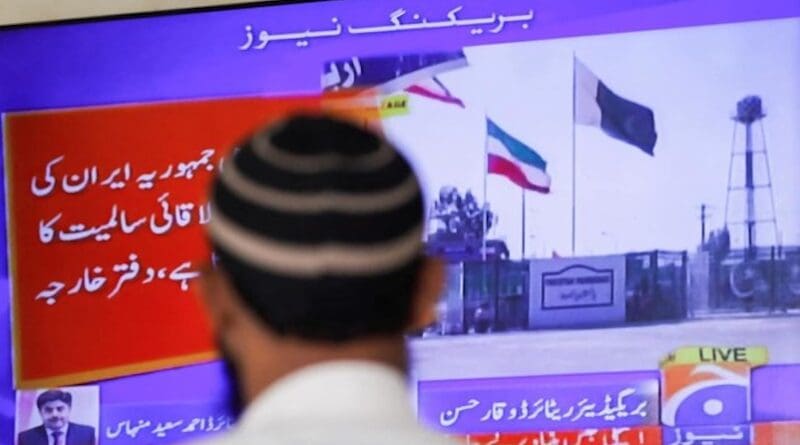Dr. Imran Khalid

In the complex landscape of South Asian geopolitics, the recent escalation of tensions between Iran and Pakistan has drawn the attention of global observers. Against the backdrop of a historical relationship marked by mistrust and periodic discord, the current situation raises concerns about the potential ramifications for regional stability.
The catalyst for the latest bout of tensions can be traced to an Iranian cross-border attack on alleged terrorist hideouts in Pakistan’s Balochistan province. The move, projected by the Iranian foreign minister as a retaliatory measure against militant activities emanating from Pakistani soil, triggered a series of responses and counter-responses, bringing the two neighbors to a critical juncture.
From a Pakistani perspective, the swift military action in response to Iran’s violation of its airspace was framed as a targeted operation against militants. Codenamed ‘Marg Bar Sarmachar’ (death to insurgents), Pakistan emphasized its commitment to eradicating terrorist elements that pose a threat to its national security. The operation, as stated by Pakistan’s Ministry of Foreign Affairs, eliminated specific terrorist hideouts within Iran’s Sistan and Baluchistan Province. After this tit for tat episode, the situation between the two countries is apparently moving towards normalization.
The puzzling timing of Iran’s unprovoked attack raises many pricking questions about its strategic objectives, especially amid heightened tensions with the United States in other parts of the region. Interestingly, on the day Iran conducted its strike, the caretaker prime minister of Pakistan engaged in a meeting with Iranian Foreign Minister Hossein Amir-Abdollahian during the World Economic Forum in Davos. The navies of both nations were also actively participating in a joint military exercise. Additionally, a Pakistani trade delegation was present in Iran, while another Iranian delegation was concurrently visiting Pakistan.
The convergence of diplomatic engagements, military exercises, and trade delegations on the same day adds a layer of complexity to the unfolding events between the two countries. The strikes were launched a day after similar attacks carried out by Tehran inside other neighbors, Iraq and Syria. The question revolves around why Tehran chose this particular time for unprovoked missile attacks in neighboring countries simultaneously, especially in a nuclear state like Pakistan, with which it has never engaged in any past conflicts.
The obvious answer can be traced to Tehran’s attempt to divert attention from the continued political and economic instability. Iran has faced intermittent political turmoil since the 1979 revolution, witnessing citizen discontent, protests, and government repression. This chronic instability has bred widespread distrust in the regime, evident in millions of people joining street protests. Economic hurdles, including inflation, unemployment, and sanctions’ fallout, have further strained Iranian society. The financial strain has restricted economic prospects, leaving many grappling with hardships and limited avenues for progress.
Widespread political unrest was unleashed in Iran from 2017, fueled by deteriorating relations with the West, international sanctions, and economic stagnation. The anti-regime protests, initiated in December of that year, persisted without abatement. By September 2022, millions of discontented individuals mobilized nationwide, presenting the most formidable challenge to the clerical regime in four decades. This dissatisfaction continues to mount, fueled by persistent issues like environmental challenges, water scarcity, transportation difficulties, brain drain, and immigration, along with surging inflation.
Iran strategically employs cross-border actions to stoke nationalist sentiments and alleviate internal pressure. Remarkably, it stands out as the singular regional nation extensively meddling in the internal affairs of neighboring states. From Lebanon to Pakistan, Tehran’s interference through proxies creates friction and instability, fostering discontent among Middle Eastern neighbors grappling with the repercussions of Iranian involvement in their internal matters. Perhaps Iran is the only country in the region which has been directly or indirectly trespassing internal affairs of its neighbors. From Lebanon to Pakistan, all neighboring countries in the Middle East have problems with Tehran’s continued interference in their internal affairs through its proxies. The recent missile strikes on specific targets in Iraq, Syria, and Pakistan reveal a chronic and threadbare strategy of provoking neighbors and the West to appease domestic unrest.
This time around, Tehran anticipated muted reactions from Iraq and Syria, customary in diplomatic protests. However, Pakistan’s prompt and precise response likely caught Iran off guard, challenging its assumptions about regional reactions to such provocations. The Iranian authorities also knew that a nuclear Pakistan would resort to more stringent retaliation if further provoked. At the same time, Iran expected Beijing’s eventual mediating role to prevent a further decline in relations with Islamabad. The outcome aligns with expectations, as Iran and Pakistan are now working toward normalizing relations. The episode offers a momentary reprieve for the Iranian regime, grappling with internal pressure and international isolation due to its alleged support for the Houthis, whose actions have disrupted global trade, notably in the Red Sea crisis.
No comments:
Post a Comment